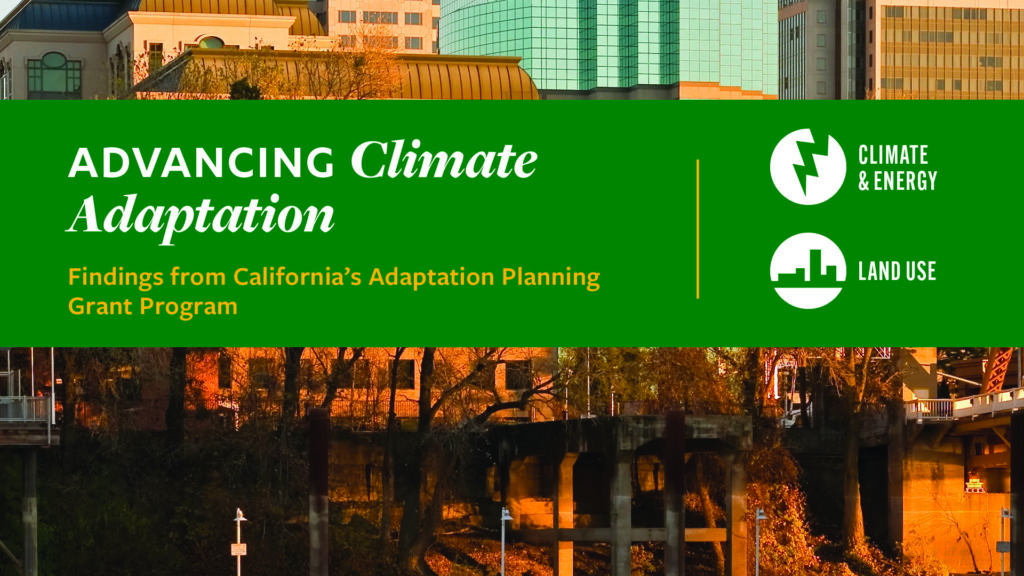How are California’s New Climate Adaptation and Resilience Grant Programs Performing?
CLEE reports analyze state’s highly in-demand adaptation and resilience grants for crucial local climate action
California is rapidly experiencing the impacts of a changing climate, from devastating wildfires and persistent droughts to rising sea levels, extreme heat, and erratic precipitation patterns. Climate adaptation is crucial for building resilience to these and other risks, thereby protecting California’s communities, economy, environment, and public health. However, effective adaptation requires significant investment, particularly in comprehensive, integrated, and equity-oriented planning processes that seek to involve and build capacity in the State’s most vulnerable communities.
California oversees a suite of adaptation and resilience grant programs, all of which are highly competitive and oversubscribed. The Integrated Climate Adaptation and Resiliency Program (ICARP) in the Governor’s Office of Planning and Research (OPR) administers several grant programs, including – the Regional Resilience Planning and Implementation Grant Program (RRGP) and the Adaptation Planning Grant Program (APGP), both established in the 2021-2022 State Budget. ICARP enlisted Berkeley’s Center for Law, Energy & the Environment (CLEE) to conduct initial assessments of the first round of RRGP and APGP, with a focus on how each achieved its goals and priorities:
- The Regional Resilience Planning and Implementation Grant Program (RRGP) advances climate resilience in California by fostering collaboration in planning, project implementation, and capacity building. OPR published the findings from CLEE’s evaluation earlier this year, which aligned with the State Legislature’s requirement for an evaluation of the program. This report is now available on CLEE’s website.
- The Adaptation Planning Grant Program (APGP) addresses local, regional, and tribal planning needs by supporting communities statewide in developing adaptation projects that address climate risks and strengthen resilience. APGP funds climate adaptation planning that addresses cross-sector issues intersecting with multiple climate risks.
Today, CLEE published the second evaluation report, summarizing findings from the assessment of APGP. Advancing Climate Adaptation: Findings from California’s Adaptation Planning Grant Program offers an in-depth assessment of the initial round of APGP, including a landscape review of State programs facilitating local and regional adaptation actions, analysis of program engagement data, findings from interviews with the 14 Round 1 grantees, and four project case studies.
Recommendations to enhance adaptation planning in California
The APGP evaluation report concludes with recommendations to enhance future iterations of APGP and improve adaptation funding in California:
- Sustain ongoing funding for adaptation planning, given continuous high demand: the State’s adaptation and resilience grant programs are oversubscribed by an average of 528%.
- Enable ICARP to provide navigation support for practitioners and applicants through structural and financial support, formalizing ICARP’s existing role as a resource in the adaptation landscape.
- Align State adaptation funding with Federal climate resilience funding through intentional program design and information sharing, facilitating a whole-of-government approach to adaptation planning.
Recommendations to improve regional resilience planning in California
The Assessment of RRGP, An Initial Review of the ICARP Regional Resilience Planning and Implementation Grant Program, evaluates the first round of RRGP. This report concludes with recommendations to improve regional approaches to building climate resilience:
- Prioritize funding for multi-risk and multi-jurisdictional projects, which enables a more holistic and integrated approach to resilience.
- Synchronize program timelines and support all phases of project development from planning through implementation.
- Sustain ongoing funding for resilience grant programs, particularly for initiatives that support the planning to implementation pipeline.
Conclusion
Adapting to climate change and building resilience in California is a multifaceted challenge that requires coordination across all levels of government. The findings from both evaluation reports suggest that, despite clear need and interest, adaptation and resilience efforts remain underfunded. Subsequently, CLEE’s recommendations underscore and build on existing directives to enhance and expand the State’s adaptation funding landscape, ensuring that communities are better prepared to face the evolving impacts of climate change.
California can strengthen its resilience and safeguard its future by prioritizing sustained adaptation funding, integrating and uplifting equity, providing necessary support for practitioners, and aligning State and Federal efforts. As climate change continues to present new challenges, proactive adaptation measures will be critical in protecting the State’s diverse populations and natural resources, ensuring a sustainable and equitable future for all Californians.
Access the full reports here:
Reader Comments
2 Replies to “How are California’s New Climate Adaptation and Resilience Grant Programs Performing?”
Comments are closed.






I’m just curious – why are these separate funding programs? What is the difference between resilience and adaptation?
Follow-up question: are there any examples of a “capital stack” as described here – “Projects resulting from the collaborative will be planned to maximize multiple related community and climate resilience benefits and lead directly to implementation planning. In doing so, they will exemplify the “capital stack” concept, simultaneously accelerating multiple foundations of long-term community resilience. ”
Does it just mean such things as that a tree will provide shade and also soak up some rain? The language in these programs sounds maddening. I’m glad I’m not the one who has to apply for these funds.
Also, I wonder if I’ve guessed the answer to my first comment – a legislator is to blame? Or, several of them?